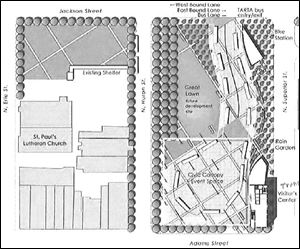
Better bus station
A plan by TARTA and city government for a new transit center could help revitalize downtown Toledo
3/3/2013
A diagram shows the configuration of the proposed bus station.
The Toledo Area Regional Transit Authority’s bus loop in downtown Toledo has major drawbacks. It often forces bus riders to wait on crowded sidewalks before they board, hampering pedestrians.
The buses-only traffic lanes the loop requires impede commuting, especially during rush hour. They obstruct the visibility of, and curbside parking for, businesses around the 12-block loop.
TARTA and Mayor Mike Bell’s administration propose a new transit hub on the block bounded by Jackson, Adams, Superior, and Huron streets. A number of obstacles must be overcome before the plan becomes reality, and legitimate objections demand to be resolved before it can proceed. But its concept is sound and deserves support.
The proposed station site is occupied by a surface parking lot and a historic building whose sole tenant is a fast-food restaurant. Proponents argue plausibly that the transit center would be a better, more efficient use of that land.
City and TARTA officials say the site is closer to downtown employers and government buildings than other proposed station locations. Passengers would get on and off buses within the block, and the buses would arrive and depart via Jackson Street, improving traffic flow.
The new station would be fully accessible to disabled riders and bicycle users. The under-used building on the block would be renovated as a visitors’ center and waiting room.
The transit station would have restrooms, public art, and other amenities: solar panels to generate power, a rain garden to manage storm water, and structural pylons that would light up at night. A civic canopy would provide space for public events, and a “great lawn” could be a site of future development.
Valentine Theatre executives complain, validly, that the loss of the 360 parking spaces in the lot across the street would cause hardship for older theater patrons. Proponents respond that their plan includes more on-street parking along Jackson Street near the station, and that the nearby Superior, Seagate, and Vistula parking garages could conveniently accommodate theatergoers.
The plan also includes inexpensive valet parking for the Valentine. Conceding the objections, planners say they are looking at maintaining some parking on the proposed site of the transit center.
Once the station opened, the city and TARTA would have to keep their promise to deal firmly with aggressive panhandlers and loiterers. But proponents of the transit center say the hub would be easier to police effectively than the current loop. The city also would have to ensure that the parking garages that would get greater use are safe, secure, and well lighted.
Similar transit centers in Cleveland, Dayton, Akron, Detroit, Grand Rapids, Mich., and Charlotte, N.C., have promoted economic growth and access to downtown entertainment and other venues as well as better mobility, proponents say. All are vital goals for downtown Toledo.
The new station wouldn’t open soon. TARTA and the city would seek federal funding for 80 percent of the project’s $23.9 million construction cost; although that money is not covered by the budget sequester, the aid is not assured.
Then the project’s planners would have to acquire private property on the block, conduct design, engineering, and environmental work, and begin construction. At best, proponents concede, the transit hub likely would not open until 2016 at the earliest.
But if these conditions are met, and the objections addressed, the proposed transit center could be a key element of downtown Toledo’s revitalization. The project is worth pursuing.